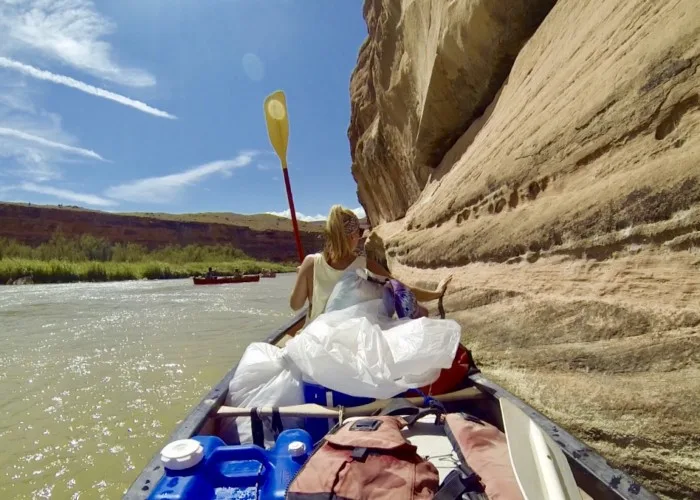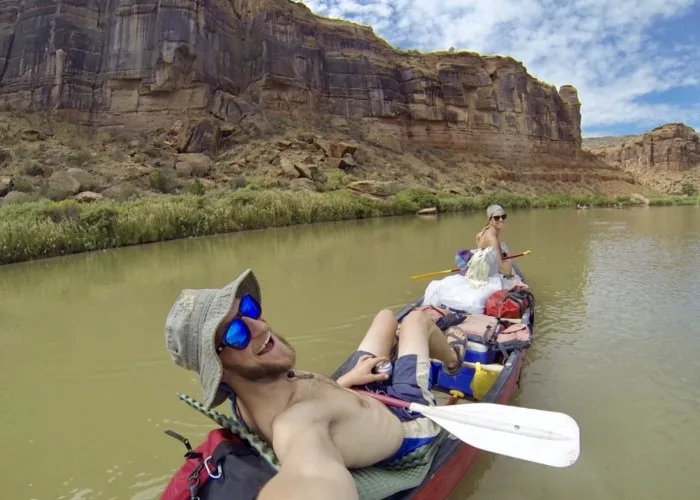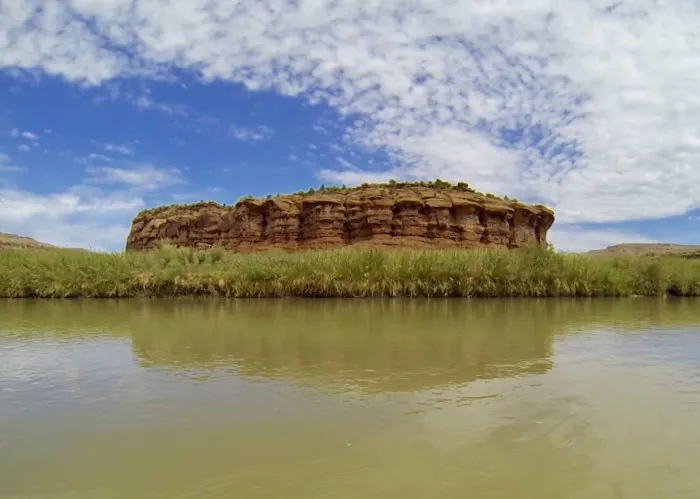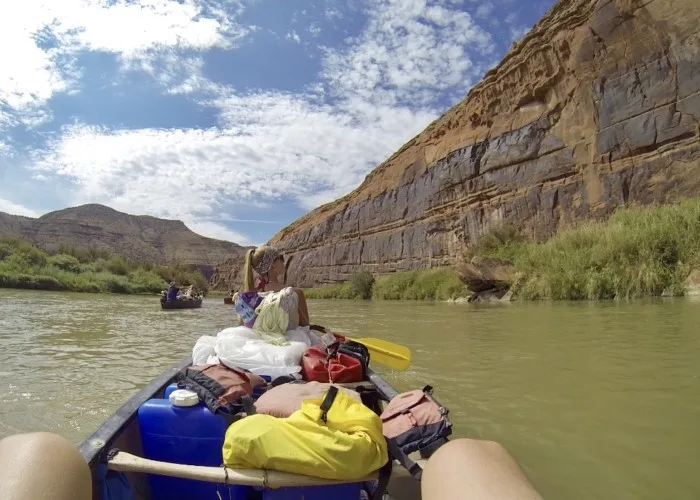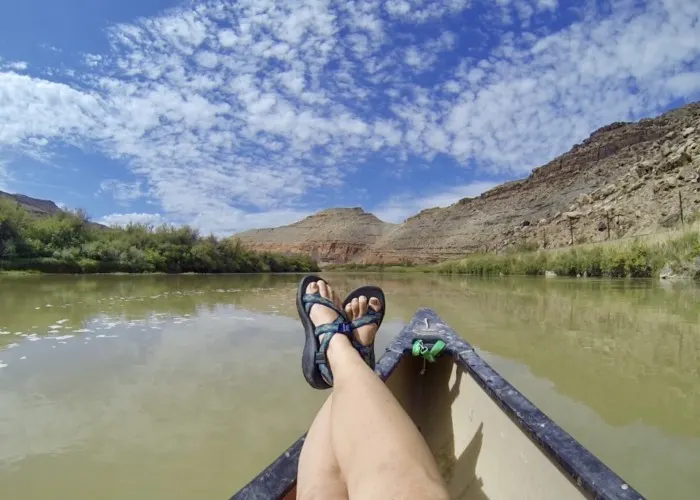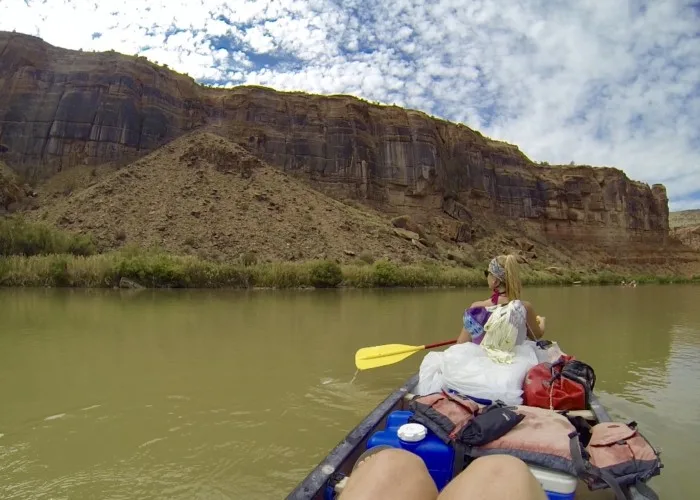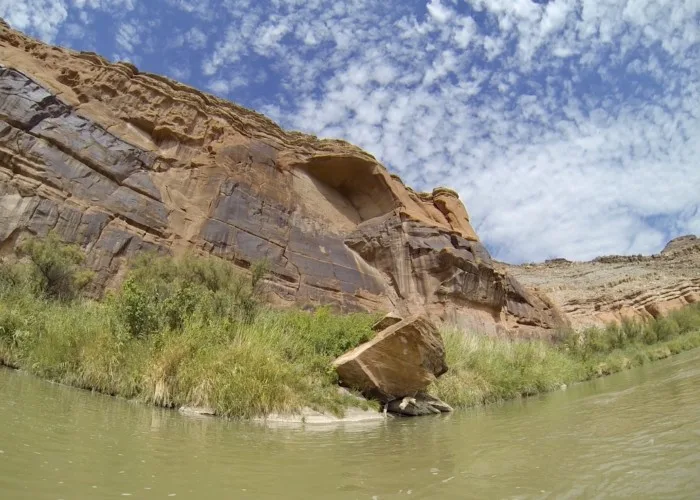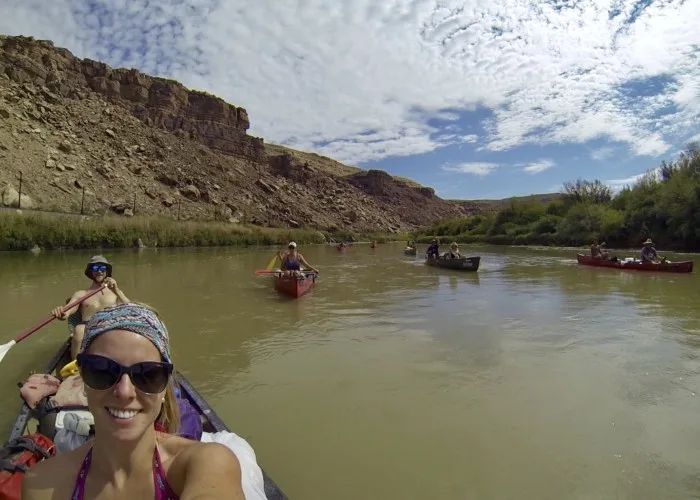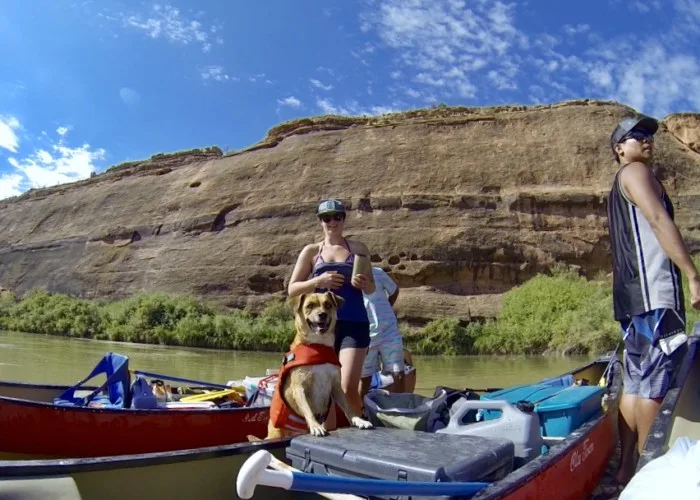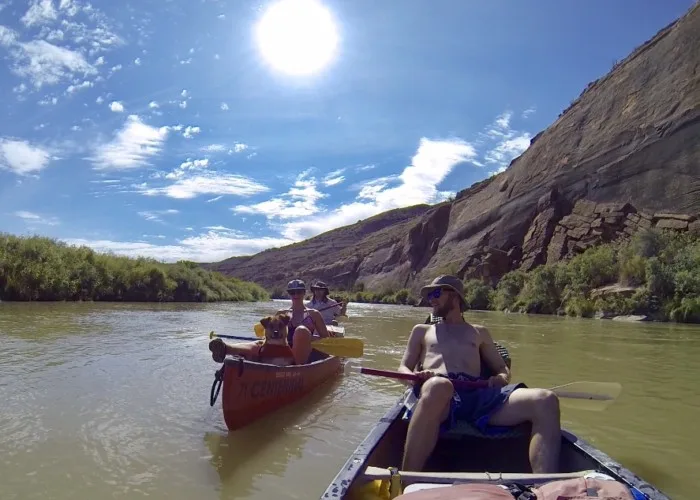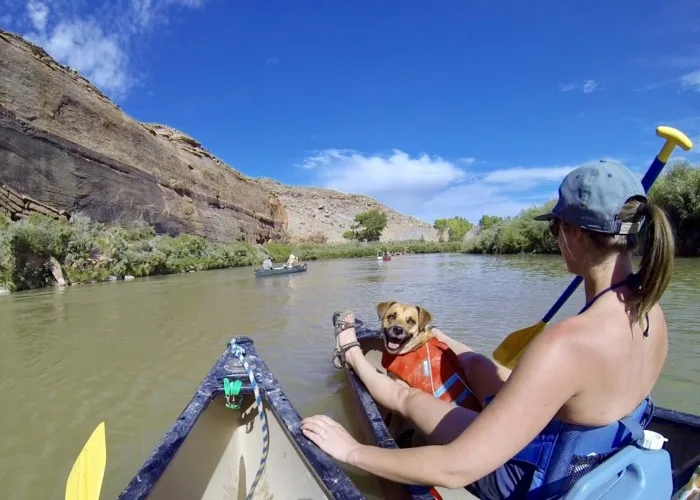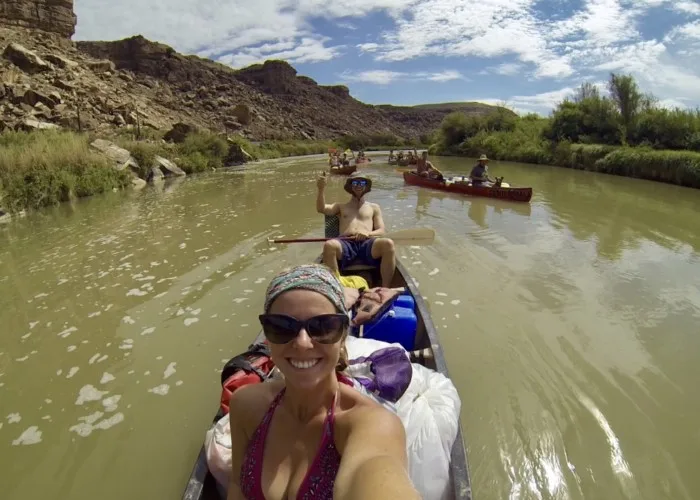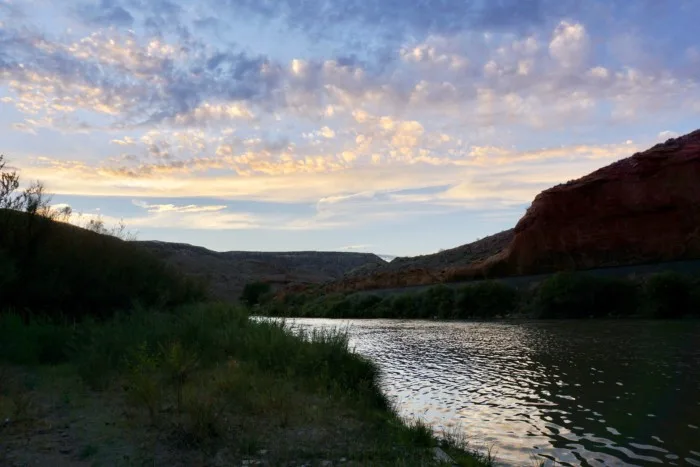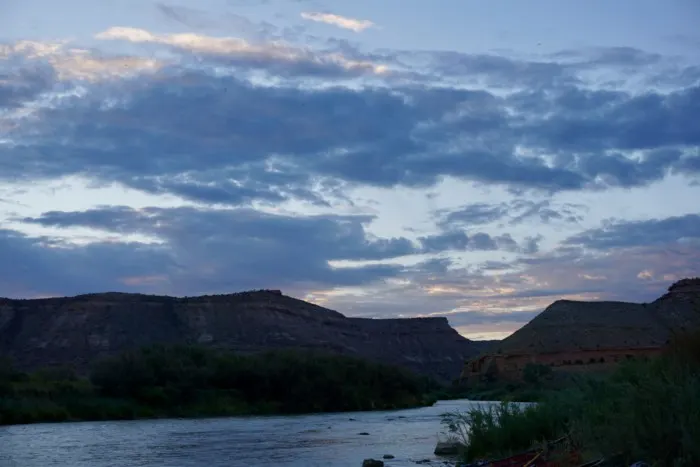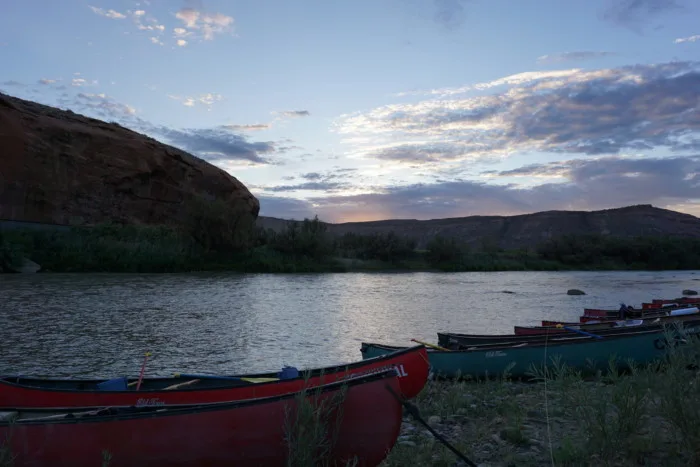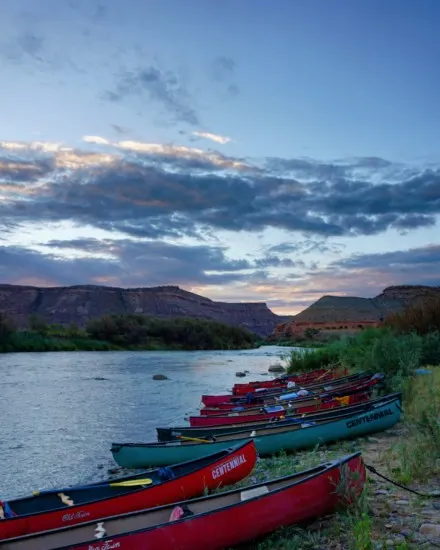
Whether it’s just you and your partner or a group, we have put together a great itinerary to help you plan an EPIC Canoe Trip! This specific canoe trip was down the Gunnison River near Delta, Colorado. Along this route you will be surrounded by tall sandstone walls. This trip is a beginner level and you will only encounter small rapids (Class 1) along the way (but some strong enough to tip your canoe). We are going to share the details from our canoe trip (42 mile float), but this info should apply to plan a canoe trip anywhere!
This post may contain affiliate links. Disclosure policy.
What Company Did We Use:
The company we used to book our trip through was Centennial Canoe. This Company also does other trips around Colorado, Utah, Wyoming & Washington.
We wouldn’t necessarily say the company has 5-star service, but it did provide us with a shuttle and canoes, so we were satisfied. We had to take the canoe’s off the trailer and put them back on, so if your group doesn’t have much muscle power, it might be a challenge.
For the price and group size we had, this company worked okay, but I would maybe suggest trying a different company first.
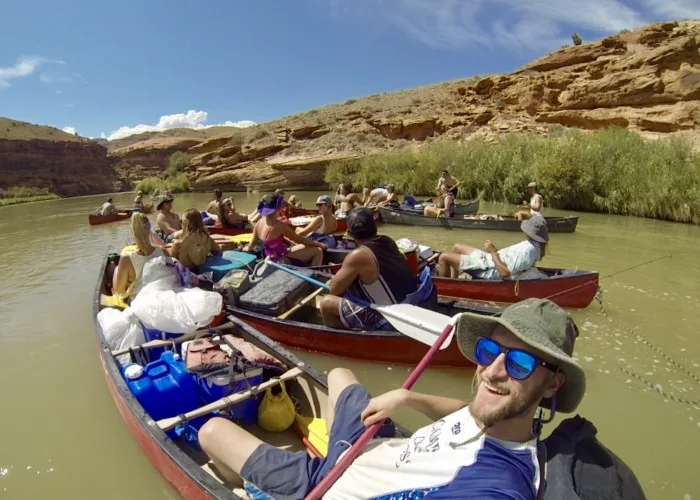
Deciding Trip Details:
- Guide: You need to decide if you want to do the canoe trip with a guide or do a self-guided trip. We chose a self-guided trip since we had some experienced canoers with us. If you have never canoed down a river, you might want to consider having a guide. If you decide to go with a different trip, check the difficulty to decide whether or not you want a guide.
- Length: Then you need to decide the length of your trip. Rental companies will likely have a variety of trips to choose from. The length of our trip was 42 miles which expects you to be on the river about 5 hrs per day (subject to change on river current). They have trips that range from 15 miles to 60 miles for this specific section of river.
- Duration: We decided to do a 3 day/2 night trip. You can choose your trip duration anywhere from 1-5 days. The length and duration will decide if you can just float, or if you have to paddle hard to keep pace. Or also if you want any free time to spend a whole day in one place, or do some hiking or other activities off the river for a day. We felt that 3 days/2 nights was the perfect duration for lazily paddling down the river, finding a campsite to play camp games and eat dinner each day. But, spending 5 hours per day on the river can get to be a bit long, especially since there is no shade. And I think we might have liked to have a little more time for hanging out at camp.
- Activities: We had a large group (24 people), so we decided we just wanted to float down the river making a couple stops each day for snacks and swimming. Then finding a campsite each afternoon to play games. (Check out our article –> Best Games For Camping) There is an additional option of hiking into Dominguez Canyon Wilderness Area, revealing cool swimming holes, waterfalls and many ancient rock art panels. (It might be best to have a guide if you decide to add those activities, so they can show you exactly where to go and store your canoes. Other fun things to do on the trip are fishing, swimming, and hammocking.
- Group Size: You can have up to 24 people if you don’t choose to have a guide, (23 people if you have a guide). Although we suggest trying to keep your group smaller (around 10/12 people). The campsites we found we’re not really large enough to accommodate 24 people. Minimum suggested age is 6, but parents have the option to take younger kids if they realize there is “no turning back”, and accept the risk.
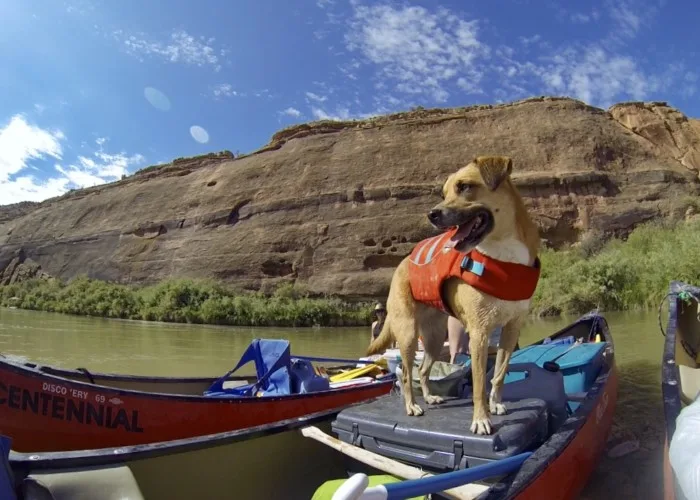
Are Dogs Allowed:
Dogs are allowed for an additional fee. I wouldn’t suggest bringing a dog if you don’t have experience canoeing. It’s hard to know how your dog will react to being on a canoe, and if it’s a larger breed they have the potential for getting spooked or restless and tipping your canoe.
The dogs we had on the trip were noticeably antsy, and didn’t like the feeling of being “trapped” on the canoe for hours at a time. That being said, they were fine once we were on land, and did enjoy other parts of the trip.
If you do bring a dog, just be sure to have a lifejacket for them, in case anything goes wrong. Also, pack it in, pack it out applies, so please carry your dog waste out with you!
Do They Provide a Shuttle:
The company listed above has a shuttle service where you park your car in a parking lot at the end of the trip (Whitewater, CO) and they shuttle you and your canoes to the start of the trip (Confluence Park). This shuttle service will take around 45 min to 1 hour. You will have to coordinate a time of expected arrival at your end destination (Whitewater, CO) so they can pick up the canoes once you are finished.
What The Company Provides:
- Canoe
- Paddle
- Water Bailers (for scooping any water out of canoes)
- Life Jackets
- Porta Potty Toilet/Toilet Paper (Leave No Trace Applies)
- Campfire Pan
Note about Lifejackets:
You are technically supposed to wear them at all times while on the river. The majority of the river is in a National Conservation Area, so Park Rangers have been known to give citations for not wearing life jackets.
Pack It In Pack It Out:
The Company we went with provided us with a Porta Potty Toilet that you need to carry in one canoe and use and pack your waste out with you. They clean it and do all the “dirty work” before and after they give it to you!
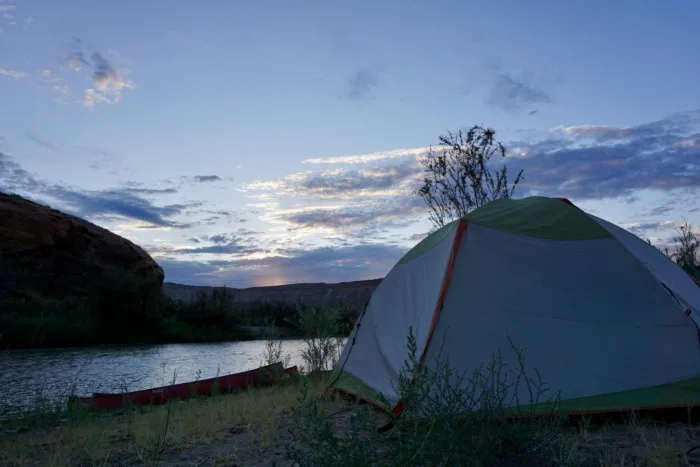
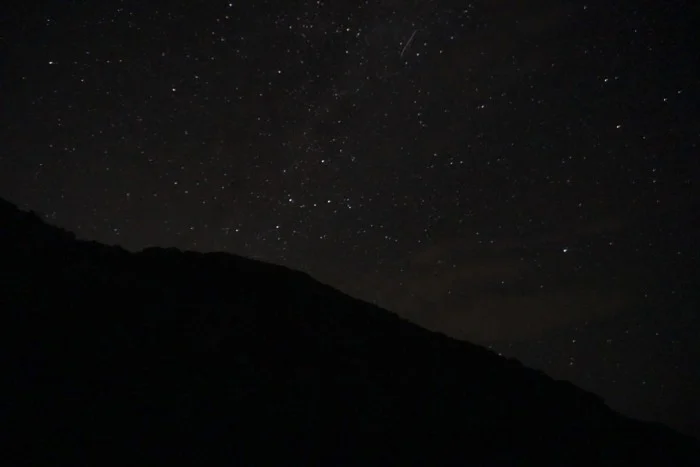
Where Are The Campsites:
There are a handful of campsites along the float. They are marked with blue, numbered signs and are first-come, first-serve. If you have a large group, campsites that are large enough are a little harder to come across.
Day 1 we canoed about 7 hours and passed a small handful of campsites, but when you adventure onto day 2 there was a long 2 hours stretch with no campsites. Night 1 we had a nice large beach with a lot of space for everyone to set up camp.
But night 2 we had to tie our canoes together and then tie them up to a tree on land because there was no beach. My advice is to just make-shift what you can!
There is also a lot of private land along the way, so you must only camp in the designated campsites with the blue signs. Private property owners are known to come by and kick people out, if you try to camp on their land.
What to Pack For A Canoe Camping Trip:
(Links to our favorite items)
- DRY BAGS are essential: (Check with your company to rent them) You will want to make sure your camping essentials are dry when you get to camp such as:
- Sleeping Bag –> Check out our article on How to Choose The Right Sleeping Bag
- Sleeping Pad –> Check out our post How To Choose The Right Sleeping Pad
- Warm Clothes: jacket, sweatshirt, thermal layer, long underwear/leggings, sweatpants
- Cell Phone
- Camera
- Tent –> Check out our post Best Tents On The Market
- Swimsuit
- GoPro
- Cooler /Yeti Cooler
- Rope/straps: It’s a good idea to have all of your belongings tied/strapped to your canoe, so if you tip you don’t lose anything down the river.
- Bungee Cords: We highly suggest using bungee cord to keep your coolers closed to keep the ice in it (in case you tip your canoe)!
- Dry-ice: If your canoe trip duration is longer than 2 days, we highly suggest having dry-ice in your cooler to make sure you keep everything cold! –> Check out our post How To Use Dry Ice In Your Cooler
- Water Jug: You will need to have a proper supply of water the whole trip duration. If you have a filter, it might be a good idea to have one in case of emergency.
- Sunscreen
- Croakies
- Sunglasses/hat
- Towel
- Bug Spray
- Trash Bags: The rules are Pack it in, pack it out
- Toiletries
- Headlamp/Flashlights
Optional:
- Biodegradable soap/shampoo&conditioner: Be friendly to the earth!
- Firewood/axe: Check for fire bans in the area, and rent a fire pan from your company.
- Waterproof Speaker
- Stadium Seat Cushion (The canoe seats are only benches and can get uncomfortable)
- Hammock
- Camp Games –> Check out our article on the Best Games For Camping
- Camp stove or Jetboil
- Campfire grate
What Food To Pack:
There isn’t a ton of room on the canoe, so if you have a group, designate someone to bring a camp stove or jetboil. Or if you can have a fire, have someone bring a campfire grate. If you have a small enough group, it might be nice to split off dinners and designate a group to make a meal each night.
- Breakfast: Some people in our group pre-made burritos (eggs, bacon, salsa) and heated it up to put in tortillas, others just made oatmeal/dehydrated meals, banana bread/muffins, or just went simple and ate an energy bar.
- Lunch: Most people pre-made sandwiches that were easy to eat while paddling. We did take pit-stops along the way where you might have a little more time, but it’s easiest if you have things prepared and ready to eat.
- Dinner: There is nothing better than a warm cooked meal at night! It’s a good idea to try and stay away from raw foods just in case your cooler tips and you lose all your ice. Therefore, a lot of us brought dehydrated meals or pre-cooked meals such as taco meat that just needed to be reheated.
Best Technique If You Tip Your Canoe:
If you happen to tip your canoe, stay calm and make sure your partner is okay. Call out to others in your group so they can be on the lookout for any lost gear. Stay with your canoe and if its too deep to touch try to swim it wherever it is shallow enough to touch.
If your in a strong current be careful of rocks. Try to drag the canoe up on land or on a rock so all the water flows to one side.
Then, bail out all the water. Hopefully, you have all your stuff tied to your canoe, so all you have to do is place it all back in the right spots and you are on your way!
Plan as if the canoe is going to flip, but then hope it doesn’t.
Jake and I flipped, but we were super prepared and so we didn’t lose anything. But our friends tipped and lost all kinds of stuff, including a cell phone because they didn’t take the time to tie everything down and keep things in waterproof bags.
Luckily we had a big group so we were all able to grab almost everything that was floating. When going through the rapids, things can change on a dime and you can lose control very quickly. You will want to make sure you have everything tied down, secure and in a dry bag/garbage bag.
We only had 2 large dry bags, so the stuff that didn’t fit in those, we packed in a duffel bag lined with garbage bags. For our food, we double bagged it in garbage bags and twisty-tied them shut.
Tips:
- Don’t stand in the canoe.
- The person in the back of the canoe needs to be the one steering.
- When you see rapids approaching, double check that everything is secured for a potential flip.
- Keep paddling through the rapids, to ensure your canoe stays straight.
- Don’t underestimate the lack of shade.
- Cover your cooler to protect it from direct sunlight.
Takeaway:
Planning a trip like this can be a lot of work, but can be very rewarding. You are surrounded by beautiful canyon walls, so be sure to look up and take in the views. This is a super fun and unique trip and we highly suggest it!
